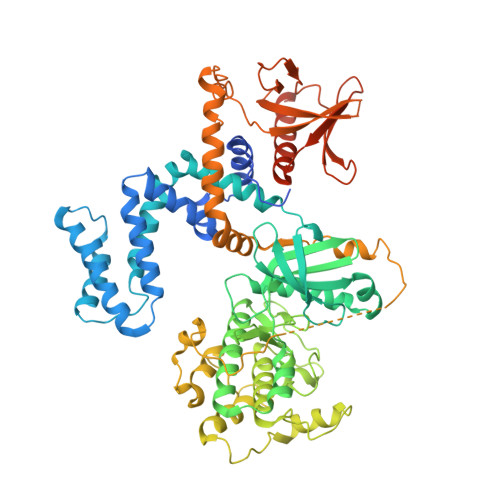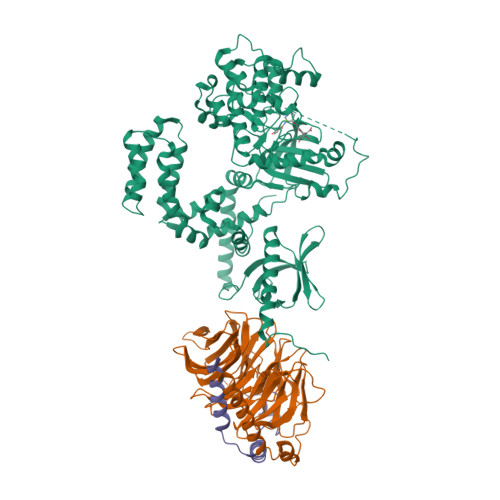
Top ▲

GtoPdb is requesting financial support from commercial users. Please see our sustainability page for more information.
 target has curated data in GtoImmuPdb
target has curated data in GtoImmuPdb
Target id: 1466
Nomenclature: beta adrenergic receptor kinase 1
Abbreviated Name: GRK2
Gene and Protein Information  |
||||||
| Species | TM | AA | Chromosomal Location | Gene Symbol | Gene Name | Reference |
| Human | - | 689 | 11q13.2 | GRK2 | G protein-coupled receptor kinase 2 | |
| Mouse | - | 689 | 19 3.98 cM | Grk2 | G protein-coupled receptor kinase 2 | |
| Rat | - | 689 | 1q43 | Grk2 | G protein-coupled receptor kinase 2 | |
Previous and Unofficial Names  |
| ADRGK1 | BARK1 | GRK2 | G-protein-coupled receptor kinase 2 | beta-AR kinase-1 | betaARK1 | adrenergic, beta, receptor kinase 1 | ADRBK1 | Adrbk1 | adrenergic |
Database Links  |
|
| Alphafold | P25098 (Hs), Q99MK8 (Mm), P26817 (Rn) |
| BRENDA | 2.7.11.15 |
| CATH/Gene3D | 2.30.29.30 |
| ChEMBL Target | CHEMBL4079 (Hs), CHEMBL3711486 (Mm), CHEMBL4105719 (Rn) |
| Ensembl Gene | ENSG00000173020 (Hs), ENSMUSG00000024858 (Mm), ENSRNOG00000018985 (Rn) |
| Entrez Gene | 156 (Hs), 110355 (Mm), 25238 (Rn) |
| Human Protein Atlas | ENSG00000173020 (Hs) |
| KEGG Enzyme | 2.7.11.15 |
| KEGG Gene | hsa:156 (Hs), mmu:110355 (Mm), rno:25238 (Rn) |
| OMIM | 109635 (Hs) |
| Pharos | P25098 (Hs) |
| RefSeq Nucleotide | NM_001619 (Hs), NM_130863 (Mm), NM_012776 (Rn) |
| RefSeq Protein | NP_001610 (Hs), NP_570933 (Mm), NP_036908 (Rn) |
| SynPHARM | 81500 (in complex with balanol) |
| UniProtKB | P25098 (Hs), Q99MK8 (Mm), P26817 (Rn) |
| Wikipedia | GRK2 (Hs) |
Selected 3D Structures  |
|||||||||||||

|
|
||||||||||||

|
|
||||||||||||

|
|
||||||||||||
Enzyme Reaction  |
||||
|
||||
Download all structure-activity data for this target as a CSV file 
| Inhibitors | |||||||||||||||||||||||||||||||||||||||||||||||||||||||||||||||||||||||||||||||||||||||||||||||||||||||||||||||||||||||||||||||||||||||||||||||||||||||||||||||||||||||||||||||||||
| Key to terms and symbols | View all chemical structures | Click column headers to sort | |||||||||||||||||||||||||||||||||||||||||||||||||||||||||||||||||||||||||||||||||||||||||||||||||||||||||||||||||||||||||||||||||||||||||||||||||||||||||||||||||||||||||||||||||
|
|||||||||||||||||||||||||||||||||||||||||||||||||||||||||||||||||||||||||||||||||||||||||||||||||||||||||||||||||||||||||||||||||||||||||||||||||||||||||||||||||||||||||||||||||||
| Inhibitor Comments | |||||||||||||||||||||||||||||||||||||||||||||||||||||||||||||||||||||||||||||||||||||||||||||||||||||||||||||||||||||||||||||||||||||||||||||||||||||||||||||||||||||||||||||||||||
| A component of agonist-induced desensitisation of the μ opioid receptor is reversed by compound 101 inhibition of GRK2/3 [10]. | |||||||||||||||||||||||||||||||||||||||||||||||||||||||||||||||||||||||||||||||||||||||||||||||||||||||||||||||||||||||||||||||||||||||||||||||||||||||||||||||||||||||||||||||||||
EMD Millipore KinaseProfilerTM screen/Reaction Biology Kinase HotspotSM screen  |
||||||||||||||||||||||||||||||||||||||||||||||||||||||||||||||||||||||||||||||||||||||||||||||||||||||||||||||||||||||||||||||||||||||||||||||||||||||||||||||||||||||||
|
A screen profiling 158 kinase inhibitors (Calbiochem Protein Kinase Inhibitor Library I and II, catalogue numbers 539744 and 539745) for their inhibitory activity at 1µM and 10µM against 234 human recombinant kinases using the EMD Millipore KinaseProfilerTM service. A screen profiling the inhibitory activity of 178 commercially available kinase inhibitors at 0.5µM against a panel of 300 recombinant protein kinases using the Reaction Biology Corporation Kinase HotspotSM platform. http://www.millipore.com/techpublications/tech1/pf3036 http://www.reactionbiology.com/webapps/main/pages/kinase.aspx Reference: ...1 |
 
|
|||||||||||||||||||||||||||||||||||||||||||||||||||||||||||||||||||||||||||||||||||||||||||||||||||||||||||||||||||||||||||||||||||||||||||||||||||||||||||||||||||||||
| Key to terms and symbols | Click column headers to sort | |||||||||||||||||||||||||||||||||||||||||||||||||||||||||||||||||||||||||||||||||||||||||||||||||||||||||||||||||||||||||||||||||||||||||||||||||||||||||||||||||||||||
| Target used in screen: nd/GRK2 | ||||||||||||||||||||||||||||||||||||||||||||||||||||||||||||||||||||||||||||||||||||||||||||||||||||||||||||||||||||||||||||||||||||||||||||||||||||||||||||||||||||||||
|---|---|---|---|---|---|---|---|---|---|---|---|---|---|---|---|---|---|---|---|---|---|---|---|---|---|---|---|---|---|---|---|---|---|---|---|---|---|---|---|---|---|---|---|---|---|---|---|---|---|---|---|---|---|---|---|---|---|---|---|---|---|---|---|---|---|---|---|---|---|---|---|---|---|---|---|---|---|---|---|---|---|---|---|---|---|---|---|---|---|---|---|---|---|---|---|---|---|---|---|---|---|---|---|---|---|---|---|---|---|---|---|---|---|---|---|---|---|---|---|---|---|---|---|---|---|---|---|---|---|---|---|---|---|---|---|---|---|---|---|---|---|---|---|---|---|---|---|---|---|---|---|---|---|---|---|---|---|---|---|---|---|---|---|---|---|---|---|---|
|
||||||||||||||||||||||||||||||||||||||||||||||||||||||||||||||||||||||||||||||||||||||||||||||||||||||||||||||||||||||||||||||||||||||||||||||||||||||||||||||||||||||||
| Displaying the top 10 most potent ligands View all ligands in screen » | ||||||||||||||||||||||||||||||||||||||||||||||||||||||||||||||||||||||||||||||||||||||||||||||||||||||||||||||||||||||||||||||||||||||||||||||||||||||||||||||||||||||||
| Immunopharmacology Comments |
| GRK2 (βARK1) expression and activity are downregulated in lymphocytes from RA patients [9]. In healthy leukocytes, pro-inflammatory cytokines reduce GRK2 expression |
Physiological Consequences of Altering Gene Expression 
|
||||||||||
|
||||||||||
|
||||||||||
| Physiological Consequences of Altering Gene Expression Comments | ||||||||||
| The essential role of GRK2 in embryonic development may not be due to its GPCR kinase activity, as mice with cardiac-specific ablation of GRK2 develop normally [6]. | ||||||||||
1. Anastassiadis T, Deacon SW, Devarajan K, Ma H, Peterson JR. (2011) Comprehensive assay of kinase catalytic activity reveals features of kinase inhibitor selectivity. Nat Biotechnol, 29 (11): 1039-45. [PMID:22037377]
2. Bouley RA, Weinberg ZY, Waldschmidt HV, Yen YC, Larsen SD, Puthenveedu MA, Tesmer JJG. (2020) A New Paroxetine-Based GRK2 Inhibitor Reduces Internalization of the μ-Opioid Receptor. Mol Pharmacol, 97 (6): 392-401. [PMID:32234810]
3. Bristow MR, Hershberger RE, Port JD, Gilbert EM, Sandoval A, Rasmussen R, Cates AE, Feldman AM. (1990) Beta-adrenergic pathways in nonfailing and failing human ventricular myocardium. Circulation, 82 (2 Suppl): I12-25. [PMID:2164894]
4. Bristow MR, Kantrowitz NE, Ginsburg R, Fowler MB. (1985) Beta-adrenergic function in heart muscle disease and heart failure. J Mol Cell Cardiol, 17 Suppl 2: 41-52. [PMID:2863387]
5. Cho SY, Lee BH, Jung H, Yun CS, Ha JD, Kim HR, Chae CH, Lee JH, Seo HW, Oh KS. (2013) Design and synthesis of novel 3-(benzo[d]oxazol-2-yl)-5-(1-(piperidin-4-yl)-1H-pyrazol-4-yl)pyridin-2-amine derivatives as selective G-protein-coupled receptor kinase-2 and -5 inhibitors. Bioorg Med Chem Lett, 23 (24): 6711-6. [PMID:24210504]
6. Dorn 2nd GW. (2009) GRK mythology: G-protein receptor kinases in cardiovascular disease. J Mol Med, 87 (5): 455-63. [PMID:19229505]
7. Jaber M, Koch WJ, Rockman H, Smith B, Bond RA, Sulik KK, Ross Jr J, Lefkowitz RJ, Caron MG, Giros B. (1996) Essential role of beta-adrenergic receptor kinase 1 in cardiac development and function. Proc Natl Acad Sci USA, 93 (23): 12974-9. [PMID:8917529]
8. Lodowski DT, Barnhill JF, Pyskadlo RM, Ghirlando R, Sterne-Marr R, Tesmer JJ. (2005) The role of G beta gamma and domain interfaces in the activation of G protein-coupled receptor kinase 2. Biochemistry, 44 (18): 6958-70. [PMID:15865441]
9. Lombardi MS, Kavelaars A, Schedlowski M, Bijlsma JW, Okihara KL, Van de Pol M, Ochsmann S, Pawlak C, Schmidt RE, Heijnen CJ. (1999) Decreased expression and activity of G-protein-coupled receptor kinases in peripheral blood mononuclear cells of patients with rheumatoid arthritis. FASEB J, 13 (6): 715-25. [PMID:10094932]
10. Lowe JD, Sanderson HS, Cooke AE, Ostovar M, Tsisanova E, Withey SL, Chavkin C, Husbands SM, Kelly E, Henderson G et al.. (2015) Role of G Protein-Coupled Receptor Kinases 2 and 3 in μ-Opioid Receptor Desensitization and Internalization. Mol Pharmacol, 88 (2): 347-56. [PMID:26013542]
11. Tesmer JJ, Tesmer VM, Lodowski DT, Steinhagen H, Huber J. (2010) Structure of human G protein-coupled receptor kinase 2 in complex with the kinase inhibitor balanol. J Med Chem, 53 (4): 1867-70. [PMID:20128603]
12. Thal DM, Homan KT, Chen J, Wu EK, Hinkle PM, Huang ZM, Chuprun JK, Song J, Gao E, Cheung JY et al.. (2012) Paroxetine is a direct inhibitor of g protein-coupled receptor kinase 2 and increases myocardial contractility. ACS Chem Biol, 7 (11): 1830-9. [PMID:22882301]
13. Thal DM, Yeow RY, Schoenau C, Huber J, Tesmer JJ. (2011) Molecular mechanism of selectivity among G protein-coupled receptor kinase 2 inhibitors. Mol Pharmacol, 80 (2): 294-303. [PMID:21596927]
14. Ungerer M, Böhm M, Elce JS, Erdmann E, Lohse MJ. (1993) Altered expression of beta-adrenergic receptor kinase and beta 1-adrenergic receptors in the failing human heart. Circulation, 87 (2): 454-63. [PMID:8381058]
15. Ungerer M, Parruti G, Böhm M, Puzicha M, DeBlasi A, Erdmann E, Lohse MJ. (1994) Expression of beta-arrestins and beta-adrenergic receptor kinases in the failing human heart. Circ Res, 74 (2): 206-13. [PMID:8293560]
16. Xie Z, Yang X, Duan Y, Han J, Liao C. (2021) Small-Molecule Kinase Inhibitors for the Treatment of Nononcologic Diseases. J Med Chem, 64 (3): 1283-1345. [PMID:33481605]
Beta-adrenergic receptor kinases (βARKs): beta adrenergic receptor kinase 1. Last modified on 18/11/2025. Accessed on 16/12/2025. IUPHAR/BPS Guide to PHARMACOLOGY, https://www.guidetopharmacology.org/GRAC/ObjectDisplayForward?objectId=1466.